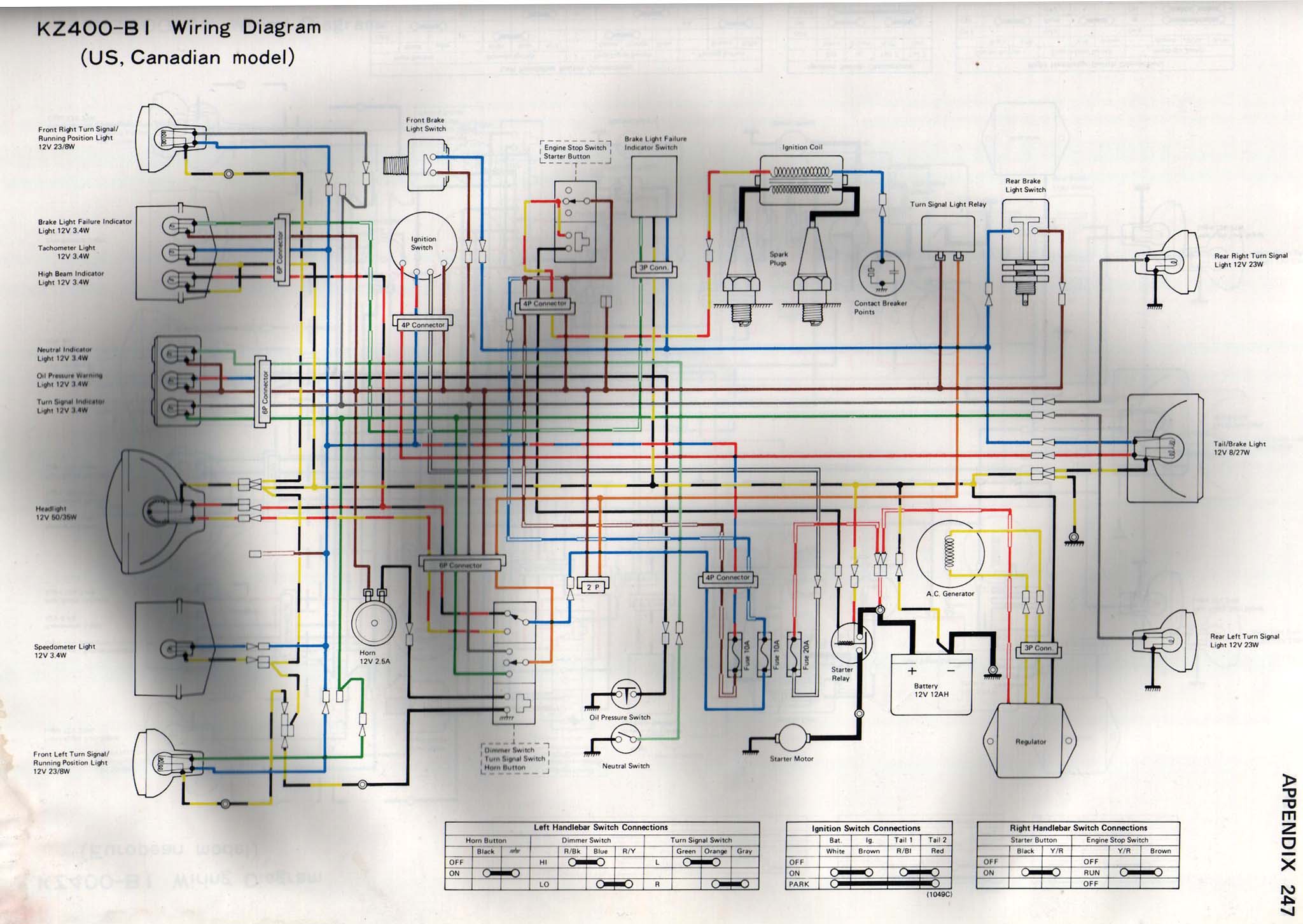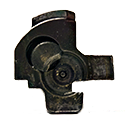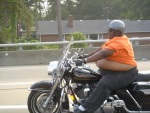|
Slavvy posted:Is it a two stroke? Ola posted:No, but Slavvy posted:That is honestly really fascinating, so it's basically got an HD evolution derivative but isn't a Harley! Care to post pics of the engine? I've literally never seen such a thing, all the big Indians (not many) I've dealt with have had the Indian-specific engine with the quaint exhaust ports, retro fins etc
|
|
|
|

|
| # ? Jun 5, 2024 21:17 |
|
If the spark needs to fire at half the rate of the signal coming off the trigger coil, that can be accomplished with a flip-flop built from two transistors.
|
|
|
Rev. Dr. Moses P. Lester posted:Oh sorry I should have said it's a 2t single. I can't imagine there's more than one spark per rev. Also a fantastically simple CDI, I took one apart once and there's like 5 total components in it, all radioshack-level. It dates to 1983ish. So I assume there's no complexities like multi pole triggering. Yeah of course, I do a lot of work for the local chopper club so I see them all the time. I'm just blown away that an indian would have a harley engine.
|
|
|
|
|
I had no idea they were making "Indian"s in 2009 before Polaris bought the name. I thought the S&S ones died out in like 2004.
|
|
|
|
Sagebrush posted:If the spark needs to fire at half the rate of the signal coming off the trigger coil, that can be accomplished with a flip-flop built from two transistors. A 2 stroke fires every revolution
|
|
|
|
There are essentially 4 eras of Indians. 1901-1953 made in Springfield, MA. 1999-2004 made in Gilroy, CA. 2009-2012 made in Kings Mountain, NC. 2014-present made in Spirit Lake, Iowa by Polaris. The Kings Mountain bikes were made after the British finance company Stellican bought the brand. The bikes were essentially hand made and were aimed at the upper end motorcycle buyer, with MSRP starting at $35,000. Unfortunately they debuted right as the global financial disaster happened so they did not sell well. They had some good ideas, but they suffered from not having a lot of experience making motorcycles and sold out to Polaris before they could get all the kinks worked out. Anyway, here are the pictures of the engine:    
|
|
|
|
Jim Silly-Balls posted:A 2 stroke fires every revolution Right, so if the trigger is making one ignition pulse per crankshaft revolution, then at 4000 rpm that should be 66.7 pulses per second. He's seeing 133Hz instead. If it's a 180-degree parallel twin with a wasted spark, then there's your answer. If it's not got that configuration, then either the CDI isn't using every pulse, or the multimeter is triggering twice on every cycle, either because the waveform is noisy or because it's picking up the other cylinder or something.
|
|
|
|
Rev. Dr. Moses P. Lester posted:
My bad, I thought I was being asked if I was referencing one.
|
|
|
SimonCat posted:There are essentially 4 eras of Indians. Really eye opening stuff, thanks for this! It's interesting that it's effectively an S&S but with every casting cosmetically different so you can barely tell. Boutique as gently caress, bet those barrels are unobtainable nowadays.
|
|
|
|
|
I've got a question on coils. First time posting in this subforum so please excuse me if I make any mistakes. Also, I'm a total noob on working on bikes. One of the goals of getting a bike was to learn to work on it myself. I've got a '81 Yamaha XJ 550 (4V8), which the previous owner modified to look like a scrambler/cafe racer/whatever. Unfortunately for me, the work he did on the bike was pretty sloppy. So, I'm in the process of tearing almost the complete bike down and checking/re-doing a lot of stuff. The electrics were a shamble so I'm completely replacing the wiring and adding in a m.unit blue. I'd like to replace the coils, too. An set of OEM or Dyna coils will cost me about $300 (cost + shipping + import duties). However, someone on the XJ forums mentioned that de coils for a Honda CB 750 80-83 were a direct swap-in. quote:DYNA COILS are great ,but Honda CB750 coils 80-83 are direct swap in and have replaceable plug wires and can still be bought new and is cheaper than the dyna coils. These are a lot cheaper, and I can get them in Europe (less than $100)! Unfortunately, they couldn't provide me with a OEM part number ... And apparently there were about 52 different models of the CB 750 in 1981 (https://www.cmsnl.com/honda-cb750_model157/).  The specs on the Yamaha ignition coils are * Primary side (input from main wiring harness): 2.5 ohms +/- 10% = 2.25 ohms - 2.75 ohms acceptable range * Secondary side (spark plug wires, without their end caps): 11K ohms +/- 20% = 8,800 ohms - 13,200 ohms acceptable range * Spark plug caps: 10K +/- 20% = 8,000 to 12,000 ohms per cap acceptable range It's a long shot but can anybody here help me with this?
|
|
|
|
Buy any of those CB750 coils, whip out your multimeter, compare the specs to what you have there for the Yammy coil and if it's not right then return it.
|
|
|
|
sixth and maimed posted:
Lots of workshop manuals are available online. Find the easiest accessible CB750 coil, then find the workshop manual pdf for the particular version. In it, look up the coil test, which will include the specs you quoted. If it's right, buy, if not, move on to the next. Hopefully the pics will show you the form factor and knowing Japanese bike makers, there won't be that much parts variance. But aren't used XJ 550 coils quite easy to get as well? You can also overhaul the ones you have by replacing the external wires and plug caps, as long as the internals measure ok.
|
|
|
|
Ola posted:Lots of workshop manuals are available online. Find the easiest accessible CB750 coil, then find the workshop manual pdf for the particular version. In it, look up the coil test, which will include the specs you quoted. If it's right, buy, if not, move on to the next. Hopefully the pics will show you the form factor and knowing Japanese bike makers, there won't be that much parts variance. Solid tip, thanks. I'll do this.
|
|
|
|
What could be the reason for surging and stuttering at low-ish (but above idle) RPM in a modern fuel-injected engine? 2017 SV650, if it matters.
|
|
|
|
emissions Bull poo poo making it run lean
|
|
|
|
It's only started recently and it's quite marked. The bike will feel like it's stalling and then give a bunch of power before settling back to what I expect from throttle position. Last week I rode at 3k RPM with no issue whatsoever.
|
|
|
|
pun pundit posted:It's only started recently and it's quite marked. The bike will feel like it's stalling and then give a bunch of power before settling back to what I expect from throttle position. Last week I rode at 3k RPM with no issue whatsoever. Is it only really at low RPM or generally when cruising? Could be an issue with the o2 sensor so it has trouble running in closed loop mode.
|
|
|
|
At 5k+ I didn't notice anything. I'll do more science on the way home.
|
|
|
|
Check your chain tension and sprocket wear before you dive into fuel/air stuff. I was getting what felt like surging at low rpm (under 3k) steady throttle and it turned out my chain was slack on worn sprockets, so when I was marginally letting off the throttle the chain was jumping around and making my engine braking very erratic. Tightening the chain fixed it right up. (I am shopping for a new chain and sprocket set this month)
|
|
|
|
prukinski posted:What's people's take on loose valve clearances, especially on low mileage engines? Slappy valves are happy valves. E: holy poo poo that was a while ago. I have not been keeping up with this thread, sorry.
|
|
|
|
pun pundit posted:At 5k+ I didn't notice anything. I'll do more science on the way home. The issue did not reoccur on my way home. Not even lugging the engine at ~2.5k in 6th up a steep hill. The only difference I can think of was that it was about 24°C when I went to work this afternoon, and about 18°C when I rode back home. Hell, maybe it was just my throttle arm being stiff while going over some bumps.
|
|
|
|
It's almost always coils
|
|
|
|
Is there a good guide or reference for jetting carb jetting besides copying what random internet ppl do? I assume the mikuni pocket tuner thing is useless for custom jets... Backstory originally I did the 3x3, full pipe and jd kit with my drz400sm. Had blue jet third clip, 155 main and 25 pilot with the extended fuel screw like 2.75 turns out. It wheelies good but in traffic sitting still getting back on the gas would make it belch white smoke. Still ran normally though. It kinda scared me though so I put the pilot jet back to the stock 22.5 and the problem went away but its hard to wheelie now
|
|
|
|
A once heard a wise man say "if it run good, send it" I'd do that.
|
|
|
|
What's your air filter situation? Maybe drill another hole in the airbox? Anyhow, I use this resource as a general carb guide: http://www.iwt.com.au/mikunicarb.htm
|
|
|
|
Hello CA! I've finally made good on my quest to pick up an old CT125 to restore and get registered for road use. This one set me back AU$500 and does run, but needs a fair bit of work/bits replacing before I think about getting it inspected. I am not super experienced at this stuff so should be an interesting learning experience!  Are these fork stanchions OK? Doesn't seem like the pitting extends to the part the fork seal travels to. If OK, what's best way to clean them off? On that, general tips for cleaning rust off various surfaces? The frame isn't bad, but all the accessories (engine guard, bark busters, luggage rack) have a fair bit of surface rust, as do the rims and exhaust. I saw a Youtube video of immmersing a bike rim in a chemical cleaner, although not sure about availablity of specific products here (or how much hassle it will be. The coating on the crank case and clutch cover is peeling off - I assume if I want to pretty those up I'll need to remove them, strip the factory coating, and redo it with something else - any suggestions? I don't have access to a sandblaster or anything like that AFAIK, and ideally it'd be something I can do in-situ so I don't have to remove the motor. It doesn't need to be perfect, looking for most efficient return on time and effort really.
|
|
|
|
Ethics_Gradient posted:Hello CA! Didn't you come in here eons ago trying to do this and complaining about motorcycle availability in your area? If I recall you almost bought a box of parts or something equally challenging. Congrats on your project. I wouldn't trust those forks. Question, for those who can read the tea leaves for me and give me hope I don't have to split cases: My Grom Big Bore journey ended about as early as I thought it might. 186cc jumped from 116c to 147c a week ago and started progressively losing power over a mile, while I downshifted and pinned the throttle, before it died. Pushed it 3 miles home in a hilly area, in full gear, at night, in Georgia summer. Good times. No loud bangs, or rattling noises, just a quiet steady struggle to live, then this:   My problem is that I have had the case covers off, oil drained, and can't find that chunk anywhere. Just a fine powder on the bottom. It's a small engine, I can either see or poke just about everywhere. Oil spinner and drain screen are clean, engine gearbox moves smoothly, and I just can't figure out where it went. Friends who build up grom engines suspect that it melted or wore away to powder over that mile. I hope maybe the piston fused to the top bit you see there, held the chunk, and got blown out the exhaust on the next 4000 strokes. I want to either go back to stock bore and a cam, or sell it and get a tdub. Haven't decided.
|
|
|
|
Coydog posted:Didn't you come in here eons ago trying to do this and complaining about motorcycle availability in your area? If I recall you almost bought a box of parts or something equally challenging. Congrats on your project. I wouldn't trust those forks. Yeah, I live in Tasmania so you're kinda locked in to whatever's available on the island unless you want to pay $500 to ship something from Melbourne (not worth it on a bike this cheap). I posted a wanted ad ages ago and after a half dozen messages from dummies on the mainland who can't read, finally found one near me. I pick up a box of spares cheap like 2 years ago when I got the idea for the project, though it's mostly small stuff like indicators, etc and there are probably some bits from other bikes in there (instrument cluster has a tacho, which I know the CT was never sold with). Not really sure what to do with the forks/front end - it needs a new tyre*, but if the forks are also shot I am tempted to see if a CR125 front end would bolt up - I know a lot of these older Hondas are parts-bin bikes and I would not mind a front disc, even if it meant also swapping out the speedo. Speaking of front ends, this bike has a 3.00-19 tyre up front, which is compatible with a 90/90-19 (although options for these are not great in terms of road trail tyres in Australia). My question is whether a 2.75-19 would also fit, because that would let me get a pair of matching Shinko SR244s as opposed to mixing and matching. Ethics_Gradient fucked around with this message at 01:56 on Jun 4, 2019 |
|
|
|
Hi pals, I'm going to check out a Honda elite 150 because I'm a huge dork, and know jack poo poo about scooters or bikes. Is there anything specific, or general, to look for? The guy said it runs and is in great shape which makes the low price suspicious, its been up for over a month. Thanks for any help!
|
|
|
|
SilvergunSuperman posted:Hi pals, Elite 150ís donít have any big gotchas. Other than making sure the pop up headlight works, itís standard bike stuff make sure it runs well, rides well, doesnít make weird noises, leak, smoke, etc Coydog posted:If I recall you almost bought a box of parts or something equally challenging Donít knock it till youíve tried it. Two of my 4 bikes came to me that way
|
|
|
|
Ethics_Gradient posted:Are these fork stanchions OK? Doesn't seem like the pitting extends to the part the fork seal travels to. If OK, what's best way to clean them off? I had rust/pitting on my fork tubes and #0000 steel wool cleaned away the surface rust, leaving the pitting for me to worry about. I eventually replaced the worse tube with a NOS part from ebay. Those forks you have look like they've got minimal pitting in the seal travel area.. but.. still not great.
|
|
|
|
Hello dear forums. I have a question. What the actual loving gently caress?  This is the wiring diagram for a 1978 KZ400. I have visually verified that this is actually how the setup looks on the bike. Please note the wiring setup for the starter button and starter relay. When the key barrel is turned to the ON position, a connection is closed between the WHITE and BROWN wire, so the BROWN wire is carrying 12 volts, is fused for 20 amps, and is carrying voltage only when the bike is ON. So far so good. If we then trace the connection of the BROWN wire to the engine cutoff switch, we find that this three-position switch closes the connection between RED/YELLOW and BROWN in the "RUN" position, indicating that the RED/YELLOW wire emanating from the engine cutoff switch is also carrying 12v, 20a fused voltage only when ON and in RUN and only connects directly to the ignition coils, energizing them. Here's where I want to stab someone. The engine start button creates a connection between the BROWN and RED/YELLOW and BLACK. This black feeds directly into the starter relay, and obviously when the start button is pressed the starter motor cranks. This means that we are sending a positive 12 volts across a BLACK wire to the positive input terminal on the starter relay solenoid. If we then trace the RED/YELLOW connection of the starter relay, we find that it connects to YELLOW/BLACK wire which in turn has a direct connection to the negative terminal of the battery, the negative terminal of the regulator, and to ground. You'll also note that the negative terminal of the regulator has a BLACK connection to the same YELLOW/BLACK common rail. So in here we have a BLACK wire mean exactly what you'd expect it to (negative/ground) and the literal opposite (+12V fused, switched), the RED/YELLOW mean more or less what you'd expect (+12V fused/switched) and the literal opposite (negative/ground). So my question is: KAWASAKI, gently caress YOU? Am I just not reading this right? Why would this happen? I guess they just wanted to make it clear at the engine cutoff switch that the black wire was operating as the (eventual) connection to the ground there? But red/yellow meaning ground at the solenoid is just asinine. And I'm pretty sure if you reverse the polarity on solenoid inputs it won't work, right?
|
|
|
|
Ethics_Gradient posted:Hello CA! Coke/soda and aluminum foil. It will remove the rust and not scratch the steel but you will still have pitting/scarring from the corrosion if its deep enough. If you want perfectly clean forks, the effort and cost to getting them looking new again (removing the rust and refinishing the metal), you could probably just find new stanchions.
|
|
|
|
Mirconium posted:Hello dear forums. I have a question. My understanding is that older bikes are wired for ground rather than wired for 12v, and that makes everything weird.  In this block I think black and red/yellow both carry 12v signals, but different positions of the switch run either of them to the brown common ground. Switch off: no path Switch "RUN": ignition coil red/yellow bridged to ground (other side of ignition coil goes to the points) Switch "START": both red/yellow and starter relay black wire bridged to ground e: uhhh, I was almost right 
mewse fucked around with this message at 22:46 on Jun 4, 2019 |
|
|
|
Thinking of replacing the whole brake system on my xr650r as they've become a little corroded with age (and stripped a bolt). Any recommendations of where to get/a brand for replacement calipers/levers? Should I just try and get some originals?
|
|
|
|
mewse posted:My understanding is that older bikes are wired for ground rather than wired for 12v, and that makes everything weird. Ok, but brown is wired to white at the ignition switch so it's continuous to the positive terminal of the battery, not the ground. When the ignition switch is on, red yellow from ignition to the coil has a potential of 0 relative to the positive terminal, and a potential of 12 relative to the negative terminal and the ground. (And is thus producing a current across the primary coil) The path is across the ignition coil and then to the points, which are grounded to the engine case. Black from the start button goes to the solenoid coil and then to ground after it passes through the solenoid coil. Edit: Ignition coils have a continuous current across them when the ignition is on, right? Then the contact breaker interrupts the connection to ground at the correct timing, the field collapses, and a high voltage is induced in the secondary coil? I am not actually 100% sure about this, but that was my impression of how they worked. (Does that mean that the ignition coil current drain is what kills a battery if you leave the ignition on, btw?) DearSirXNORMadam fucked around with this message at 23:12 on Jun 4, 2019 |
|
|
|
Mirconium posted:Ok, but brown is wired to white at the ignition switch so it's continuous to the positive terminal of the battery, not the ground. OK so negative terminal of battery > red/yellow > starter relay > black > starter button > (if on) yellow/red > engine stop switch > (if RUN) brown > ignition switch > white > positive terminal of battery. quote:Black from the start button goes to the solenoid coil and then to ground after it passes through the solenoid coil. I think you're getting confused thinking the small black line and large black lines on the solenoid diagram are connected.  Relays have a signal side and a power side, the two small lines on the left is the signal and the thick line on the right is the power distribution wire that gets switched on/off by the signal. With the relay on, the battery is basically directly powering the starter motor since the negative terminal is "grounded". 
|
|
|
|
mewse posted:OK so negative terminal of battery > red/yellow > starter relay > black > starter button > (if on) yellow/red > engine stop switch > (if RUN) brown > ignition switch > white > positive terminal of battery. I got all that, but check out where the red yellow from the solenoid goes. It goes positive terminal > red/white > fuse > white > ignition switch > brown > start switch > black > solenoid coil > red/yellow > yellow/black > ground. I get that the small black is not the same as the power side of the relay, but the signal side of the solenoid has a black wire connected to the positive voltage side of it and red yellow to the ground side of it. The red yellow that leaves the signal side of the relay is grounded. This is the opposite of the usual convention, is it not? ninja edit: solenoid != relay
|
|
|
|
People did lots of drugs in the 70ís Also black being ground is a very 70ís Yamaha move. Kawi looks weíre usually pretty competent. Look at it this way: Yamaha maybe used more sane cable coloring but also used the lighting system as a voltage regulator and ran their stators as starter motors. It could be worse.
|
|
|
|

|
| # ? Jun 5, 2024 21:17 |
|
So I just got some Michelin Road 5s on my Zx6r, and they seem great in the wet, if a bit slow handling compared to my old Dunlop Q3s. Only issue now is that I can hear a whine from the tyres when riding straight ahead. Sounds like the whine from an off road car tyre on the freeway, and quietens down whilst leaning over. The noise is only present while riding between around 30-65kph. Is this something I should be going back to the shop for or is this normal? I've never actually heard tyre noise on a bike before!
|
|
|
































